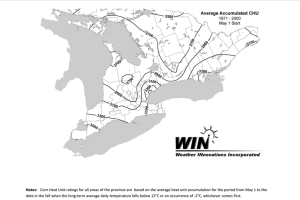HOME PREVIOUS ARTICLE NEXT ARTICLE
By Kelsey Banks, Ottawa-Rideau Regional Communication Coordinator
For many growers, the same corn hybrid is chosen every year out of habit rather than data. For the most part, that sometimes works. However, it is important to look at the data behind the hybrids in order to choose the best corn hybrid that works for you and your farm business.
In Ontario, we are fortunate to be able to find most of the corn hybrid data on a website called gocorn.net. By clicking on ‘Hybrid Corn Performance Trial 2021’ then selecting ‘Area 3 East: Bainsville, Iroquois, Winchester’ in either an excel sheet, PDF, or graph format you can see the results of the variety from 2021.
The first thing to look for is the corn heat units (CHU) that you typically purchase for your area. If you are unsure of what CHU you should be looking for, there are updated CHU maps available on gocorn.net. Using the example situation outlined earlier, let’s say we are located in Morrisburg. Looking at this map (image here), we are in the 2900 CHU area. Depending on if the corn will be going for feed or grain, the CHU and specific variety of the hybrid may change due to the amount of foliage. Looking at the data for the hybrids we are looking at the 2825–2850 CHU; you can see the data from the previous year’s corn performance trials that have been conducted by the Ontario Corn Committee.
The best way to explain the data that is being presented is by understanding what is being measured:
GM Trait – There are different codes for different types of genetically modified hybrids.
Seed Treatment – There are different seed treatments used typically based on the brand of the hybrid.
Yield Index – As stated in the Explanatory Package on GoCorn.net, “The index in the tables indicates a percent of the average of all hybrids included in the trial(s). Index figures above 100 reflect the percentage by which a hybrid is above the average, and index figures below 100 show the percent below average”
Moisture % – “The accuracy of moisture measurement decreases as moisture content increases. Results for hybrids with very high moisture contents should be interpreted with caution.” (gocorn.net)
Lodging % – Lodged Plants includes plants with stalks that are broken below the ear and plants leaning such that the ear is in the adjacent row or otherwise unharvestable. Because all hybrids in a trial are harvested on the same date, the early hybrids within each table tend to show a greater amount of stalk breakage than do later hybrids. Stalk strength should be compared only with hybrids of the same maturity.
Looking at the data being presented and while keeping your goals in mind, you can then select hybrids that may work for you. Once you have narrowed your top four hybrids, you can see how they compare against each other using the Ontario Corn Committee ‘Corn Selector’ tool that is located on the home page of gocorn.net.
Although this data is important to keep in mind, it is also important to remember other factors, such as what your soil type is, what hybrids work best in your soil, your tillage type, cropping system and other factors that should be considered when making your corn hybrid decision.
To determine your next crop year’s corn hybrid, please contact your local agronomist.